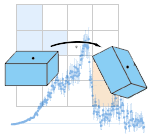
| HOME | PEOPLE | RESEARCH | ACADEMICS | TRAVEL/VISITORS | LINKS | CONTACT |

|
Web Mail
Mailing Lists
Computing Resources
Site Map
Modern Flow Stability: Theory, Computations, and Experiments in Near Wall Turbulence
Kumar Bobba, Graduate Aeronautical Laboratories, California Institute of Technology
Tuesday, May 11, 20044:00 PM to 5:00 PM
Guggenheim 101
(Lees-Kubota Lecture Hall)
Helmholtz established the field of hydrodynamic stability with his pioneering work in 1868. From then on, hydrodynamic stability became a important tool in understanding various fundamental fluid flow phenomena in engineering (mechanical, aeronautics, chemical, materials, civil, etc.) and science (astrophysics, geophysics, biophysics, etc.), and turbulence in particular. However, there are many discrepancies between classical hydrodynamic stability theory and experiments.
In this work, the limitations of traditional hydrodynamic stability theory are shown and a framework for modern hydrodynamic stability theory is formulated. A host of new techniques like gramians, singular values, operator norms, etc. are introduced to understand the role of various kinds of uncertainty. An interesting feature of this framework is the close interplay between theory and computations.
It is shown that a subset of Navier-Stokes equations are globally, non-nonlinearly stable for all Reynolds number. Yet, invoking this new theory, it is shown that these equations produce structures (vortices and streaks) as seen in the experiments. The experiments are done in zero pressure gradient transiting boundary layer on a flat plate in free surface tunnel. Digital particle image velocimetry, and MEMS based laser Doppler velocimeter and shear stress sensors have been used to make quantitative measurements of the flow. Various theoretical and computational predictions are in excellent agreement with the experimental data.
A closely related topic of modeling, simulation and complexity reduction of large mechanics problems with multiple spatial and temporal scales is also studied. A nice method that rigorously quantifies the important scales and automatically gives models of the problem to various levels of accuracy is introduced. Computations done using spectral methods will be presented.
|
©2003-2011 California Institute of Technology. All Rights Reserved webmaster |
|